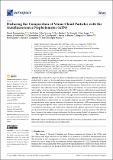Deducing the Composition of Venus Cloud Particles with the Autofluorescence Nephelometer (AFN)
Author(s)
Baumgardner, Darrel; Fisher, Ted; Newton, Roy; Roden, Chris; Zmarzly, Pat; Seager, Sara; Petkowski, Janusz J.; Carr, Christopher E.; Špaček, Jan; Benner, Steven A.; Tolbert, Margaret A.; Jansen, Kevin; Grinspoon, David H.; Mandy, Christophe; ... Show more Show less
Downloadaerospace-09-00492-v2.pdf (3.420Mb)
Publisher with Creative Commons License
Publisher with Creative Commons License
Creative Commons Attribution
Terms of use
Metadata
Show full item recordAbstract
The composition, sizes and shapes of particles in the clouds of Venus have previously been studied with a variety of in situ and remote sensor measurements. A number of major questions remain unresolved, however, motivating the development of an exploratory mission that will drop a small probe, instrumented with a single-particle autofluorescence nephelometer (AFN), into Venus’s atmosphere. The AFN is specifically designed to address uncertainties associated with the asphericity and complex refractive indices of cloud particles. The AFN projects a collimated, focused, linearly polarized, 440 nm wavelength laser beam through a window of the capsule into the airstream and measures the polarized components of some of the light that is scattered by individual particles that pass through the laser beam. The AFN also measures fluorescence from those particles that contain material that fluoresce when excited at a wavelength of 440 nm and emit at 470–520 nm. Fluorescence is expected from some organic molecules if present in the particles. AFN measurements during probe passage through the Venus clouds are intended to provide constraints on particle number concentration, size, shape, and composition. Hypothesized organics, if present in Venus aerosols, may be detected by the AFN as a precursor to precise identification via future missions. The AFN has been chosen as the primary science instrument for the upcoming Rocket Lab mission to Venus, to search for organic molecules in the cloud particles and constrain the particle composition.
Date issued
2022-09-02Department
Massachusetts Institute of Technology. Department of Earth, Atmospheric, and Planetary Sciences; Massachusetts Institute of Technology. Department of Physics; Massachusetts Institute of Technology. Department of Aeronautics and AstronauticsPublisher
Multidisciplinary Digital Publishing Institute
Citation
Aerospace 9 (9): 492 (2022)
Version: Final published version